trailer CHEVROLET DURAMAX 2006 Owners Manual
[x] Cancel search | Manufacturer: CHEVROLET, Model Year: 2006, Model line: DURAMAX, Model: CHEVROLET DURAMAX 2006Pages: 100, PDF Size: 0.71 MB
Page 8 of 100
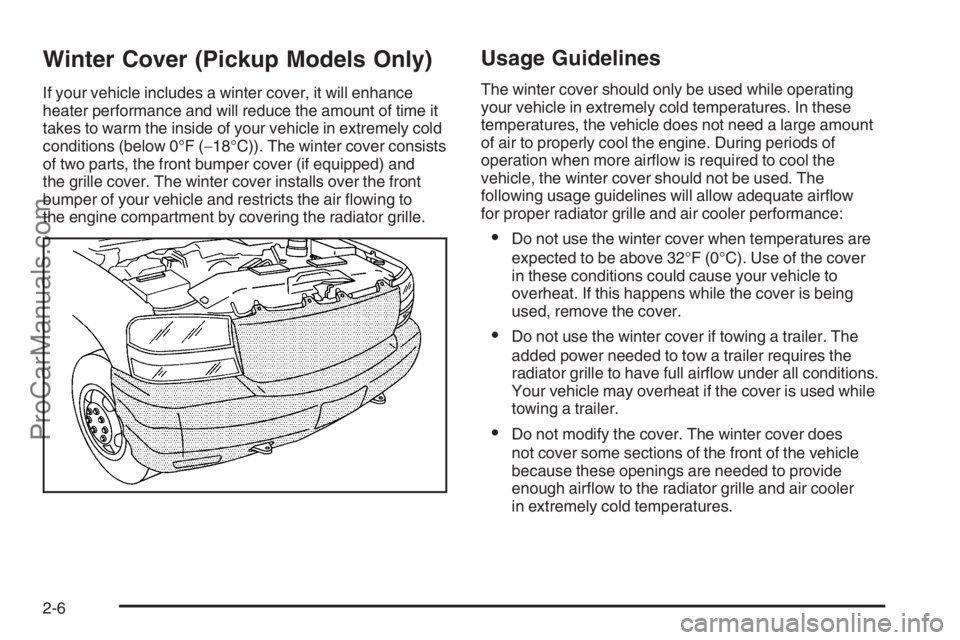
Winter Cover (Pickup Models Only)
If your vehicle includes a winter cover, it will enhance
heater performance and will reduce the amount of time it
takes to warm the inside of your vehicle in extremely cold
conditions (below 0°F (−18°C)). The winter cover consists
of two parts, the front bumper cover (if equipped) and
the grille cover. The winter cover installs over the front
bumper of your vehicle and restricts the air flowing to
the engine compartment by covering the radiator grille.
Usage Guidelines
The winter cover should only be used while operating
your vehicle in extremely cold temperatures. In these
temperatures, the vehicle does not need a large amount
of air to properly cool the engine. During periods of
operation when more airflow is required to cool the
vehicle, the winter cover should not be used. The
following usage guidelines will allow adequate airflow
for proper radiator grille and air cooler performance:
•Do not use the winter cover when temperatures are
expected to be above 32°F (0°C). Use of the cover
in these conditions could cause your vehicle to
overheat. If this happens while the cover is being
used, remove the cover.
•Do not use the winter cover if towing a trailer. The
added power needed to tow a trailer requires the
radiator grille to have full airflow under all conditions.
Your vehicle may overheat if the cover is used while
towing a trailer.
•Do not modify the cover. The winter cover does
not cover some sections of the front of the vehicle
because these openings are needed to provide
enough airflow to the radiator grille and air cooler
in extremely cold temperatures.
2-6
ProCarManuals.com
Page 23 of 100
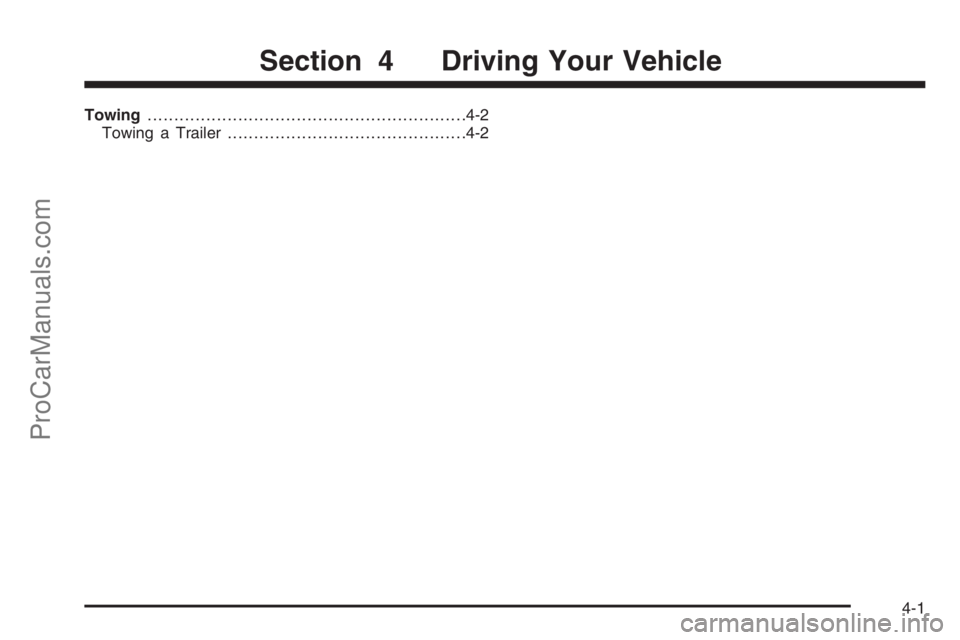
Towing............................................................4-2
Towing a Trailer.............................................4-2
Section 4 Driving Your Vehicle
4-1
ProCarManuals.com
Page 24 of 100
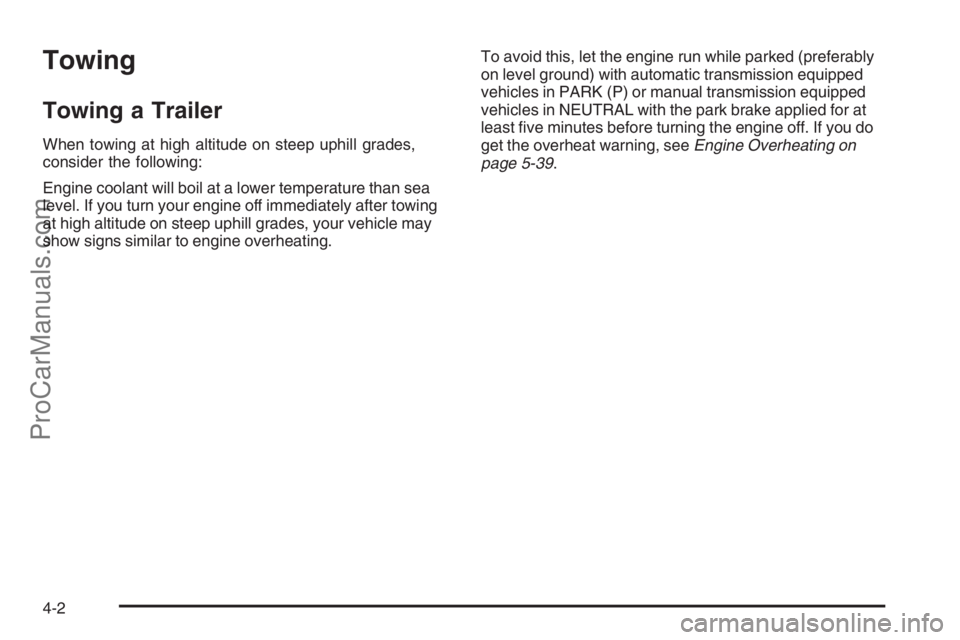
Towing
Towing a Trailer
When towing at high altitude on steep uphill grades,
consider the following:
Engine coolant will boil at a lower temperature than sea
level. If you turn your engine off immediately after towing
at high altitude on steep uphill grades, your vehicle may
show signs similar to engine overheating.To avoid this, let the engine run while parked (preferably
on level ground) with automatic transmission equipped
vehicles in PARK (P) or manual transmission equipped
vehicles in NEUTRAL with the park brake applied for at
least five minutes before turning the engine off. If you do
get the overheat warning, seeEngine Overheating on
page 5-39.
4-2
ProCarManuals.com
Page 53 of 100
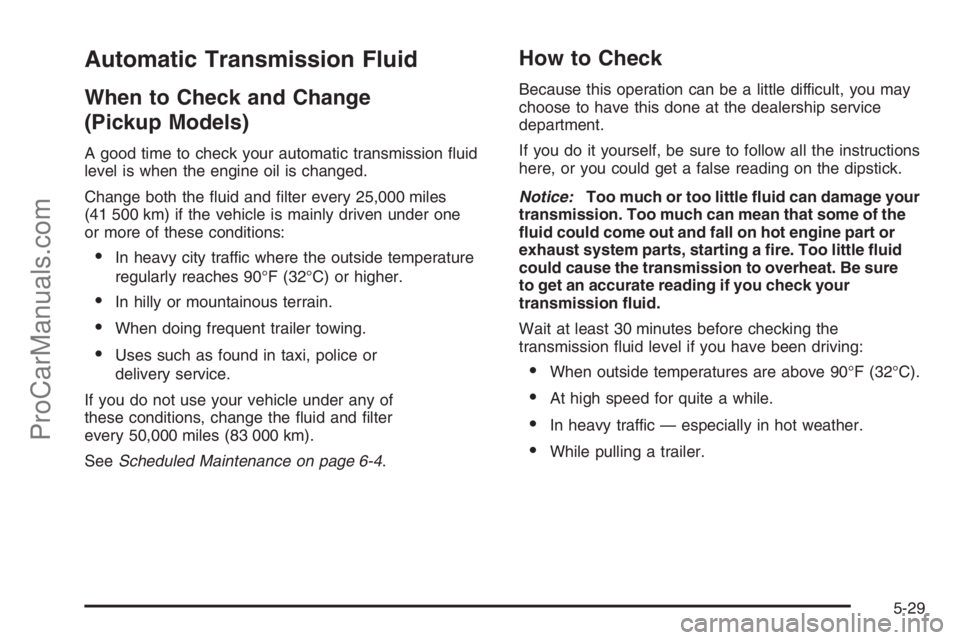
Automatic Transmission Fluid
When to Check and Change
(Pickup Models)
A good time to check your automatic transmission fluid
level is when the engine oil is changed.
Change both the fluid and filter every 25,000 miles
(41 500 km) if the vehicle is mainly driven under one
or more of these conditions:
•In heavy city traffic where the outside temperature
regularly reaches 90°F (32°C) or higher.
•In hilly or mountainous terrain.
•When doing frequent trailer towing.
•Uses such as found in taxi, police or
delivery service.
If you do not use your vehicle under any of
these conditions, change the fluid and filter
every 50,000 miles (83 000 km).
SeeScheduled Maintenance on page 6-4.
How to Check
Because this operation can be a little difficult, you may
choose to have this done at the dealership service
department.
If you do it yourself, be sure to follow all the instructions
here, or you could get a false reading on the dipstick.
Notice:Too much or too little �uid can damage your
transmission. Too much can mean that some of the
�uid could come out and fall on hot engine part or
exhaust system parts, starting a �re. Too little �uid
could cause the transmission to overheat. Be sure
to get an accurate reading if you check your
transmission �uid.
Wait at least 30 minutes before checking the
transmission fluid level if you have been driving:
•When outside temperatures are above 90°F (32°C).
•At high speed for quite a while.
•In heavy traffic — especially in hot weather.
•While pulling a trailer.
5-29
ProCarManuals.com
Page 56 of 100
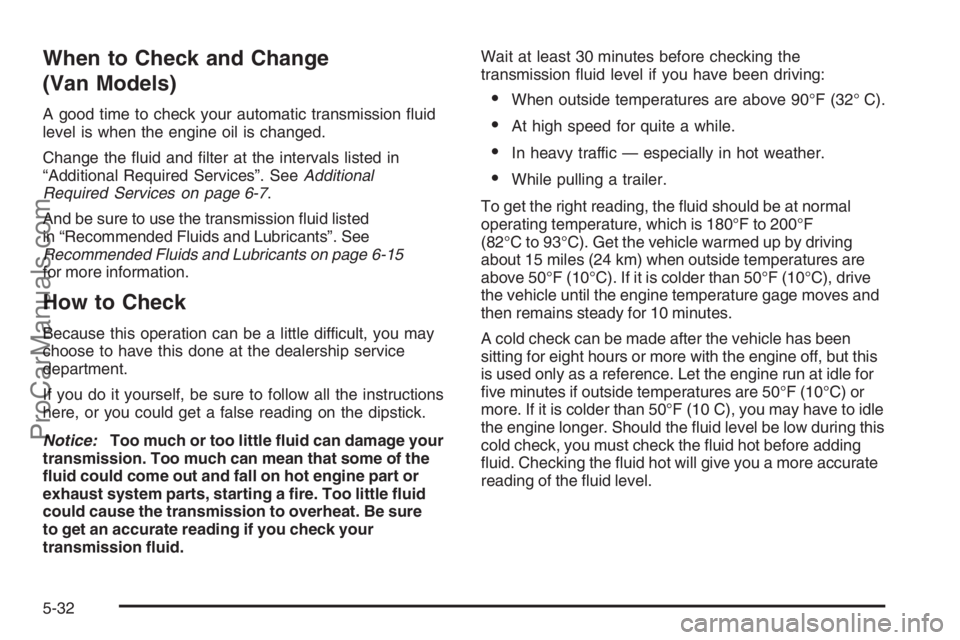
When to Check and Change
(Van Models)
A good time to check your automatic transmission fluid
level is when the engine oil is changed.
Change the fluid and filter at the intervals listed in
“Additional Required Services”. SeeAdditional
Required Services on page 6-7.
And be sure to use the transmission fluid listed
in “Recommended Fluids and Lubricants”. See
Recommended Fluids and Lubricants on page 6-15
for more information.
How to Check
Because this operation can be a little difficult, you may
choose to have this done at the dealership service
department.
If you do it yourself, be sure to follow all the instructions
here, or you could get a false reading on the dipstick.
Notice:Too much or too little �uid can damage your
transmission. Too much can mean that some of the
�uid could come out and fall on hot engine part or
exhaust system parts, starting a �re. Too little �uid
could cause the transmission to overheat. Be sure
to get an accurate reading if you check your
transmission �uid.Wait at least 30 minutes before checking the
transmission fluid level if you have been driving:
•When outside temperatures are above 90°F (32° C).
•At high speed for quite a while.
•In heavy traffic — especially in hot weather.
•While pulling a trailer.
To get the right reading, the fluid should be at normal
operating temperature, which is 180°F to 200°F
(82°C to 93°C). Get the vehicle warmed up by driving
about 15 miles (24 km) when outside temperatures are
above 50°F (10°C). If it is colder than 50°F (10°C), drive
the vehicle until the engine temperature gage moves and
then remains steady for 10 minutes.
A cold check can be made after the vehicle has been
sitting for eight hours or more with the engine off, but this
is used only as a reference. Let the engine run at idle for
five minutes if outside temperatures are 50°F (10°C) or
more. If it is colder than 50°F (10 C), you may have to idle
the engine longer. Should the fluid level be low during this
cold check, you must check the fluid hot before adding
fluid. Checking the fluid hot will give you a more accurate
reading of the fluid level.
5-32
ProCarManuals.com
Page 64 of 100
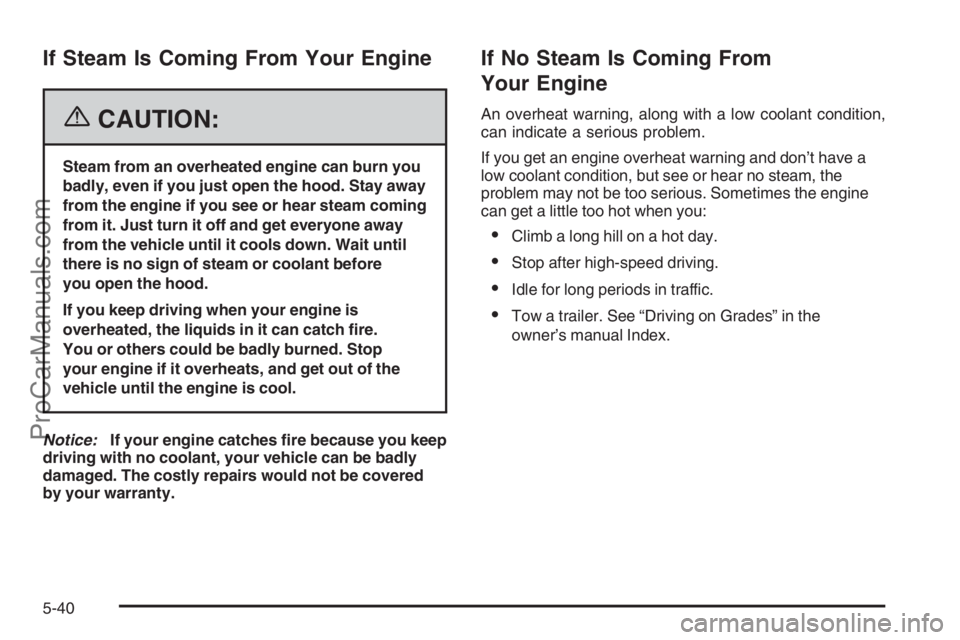
If Steam Is Coming From Your Engine
{CAUTION:
Steam from an overheated engine can burn you
badly, even if you just open the hood. Stay away
from the engine if you see or hear steam coming
from it. Just turn it off and get everyone away
from the vehicle until it cools down. Wait until
there is no sign of steam or coolant before
you open the hood.
If you keep driving when your engine is
overheated, the liquids in it can catch �re.
You or others could be badly burned. Stop
your engine if it overheats, and get out of the
vehicle until the engine is cool.
Notice:If your engine catches �re because you keep
driving with no coolant, your vehicle can be badly
damaged. The costly repairs would not be covered
by your warranty.
If No Steam Is Coming From
Your Engine
An overheat warning, along with a low coolant condition,
can indicate a serious problem.
If you get an engine overheat warning and don’t have a
low coolant condition, but see or hear no steam, the
problem may not be too serious. Sometimes the engine
can get a little too hot when you:
•Climb a long hill on a hot day.
•Stop after high-speed driving.
•Idle for long periods in traffic.
•Tow a trailer. See “Driving on Grades” in the
owner’s manual Index.
5-40
ProCarManuals.com
Page 85 of 100
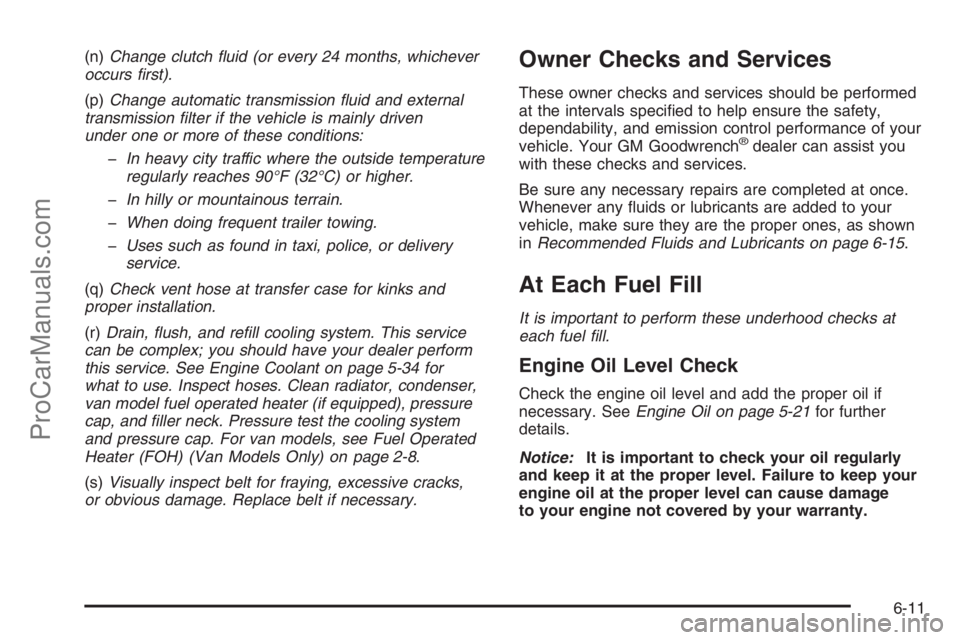
(n)Change clutch �uid (or every 24 months, whichever
occurs �rst).
(p)Change automatic transmission �uid and external
transmission �lter if the vehicle is mainly driven
under one or more of these conditions:
-In heavy city traffic where the outside temperature
regularly reaches 90°F (32°C) or higher.
-In hilly or mountainous terrain.
-When doing frequent trailer towing.
-Uses such as found in taxi, police, or delivery
service.
(q)Check vent hose at transfer case for kinks and
proper installation.
(r)Drain, �ush, and re�ll cooling system. This service
can be complex; you should have your dealer perform
this service. See Engine Coolant on page 5-34 for
what to use. Inspect hoses. Clean radiator, condenser,
van model fuel operated heater (if equipped), pressure
cap, and �ller neck. Pressure test the cooling system
and pressure cap. For van models, see Fuel Operated
Heater (FOH) (Van Models Only) on page 2-8.
(s)Visually inspect belt for fraying, excessive cracks,
or obvious damage. Replace belt if necessary.Owner Checks and Services
These owner checks and services should be performed
at the intervals specified to help ensure the safety,
dependability, and emission control performance of your
vehicle. Your GM Goodwrench
®dealer can assist you
with these checks and services.
Be sure any necessary repairs are completed at once.
Whenever any fluids or lubricants are added to your
vehicle, make sure they are the proper ones, as shown
inRecommended Fluids and Lubricants on page 6-15.
At Each Fuel Fill
It is important to perform these underhood checks at
each fuel �ll.
Engine Oil Level Check
Check the engine oil level and add the proper oil if
necessary. SeeEngine Oil on page 5-21for further
details.
Notice:It is important to check your oil regularly
and keep it at the proper level. Failure to keep your
engine oil at the proper level can cause damage
to your engine not covered by your warranty.
6-11
ProCarManuals.com
Page 100 of 100
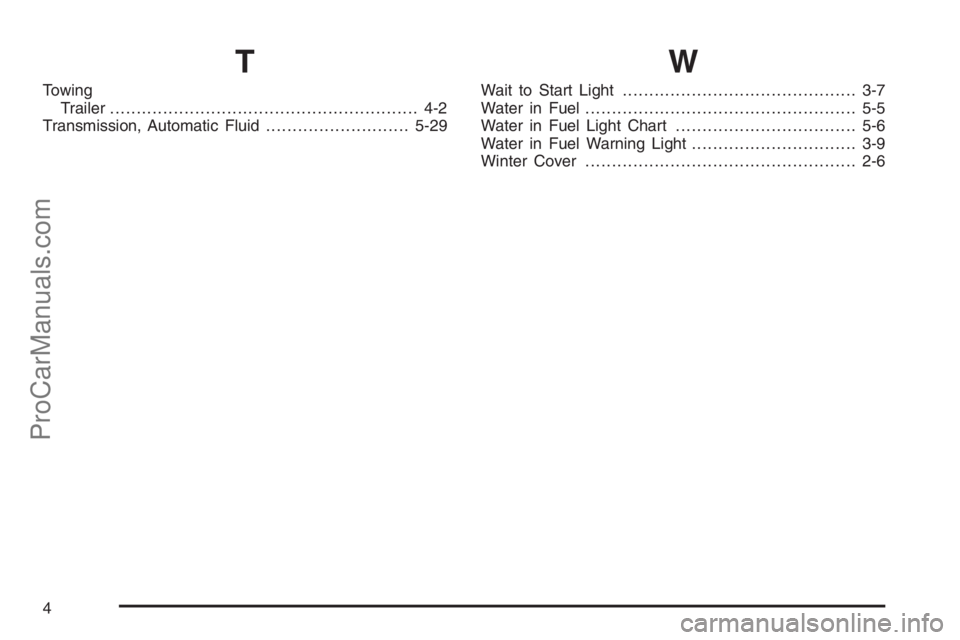
T
Towing
Trailer.......................................................... 4-2
Transmission, Automatic Fluid...........................5-29
W
Wait to Start Light............................................ 3-7
Water in Fuel................................................... 5-5
Water in Fuel Light Chart.................................. 5-6
Water in Fuel Warning Light............................... 3-9
Winter Cover................................................... 2-6
4
ProCarManuals.com